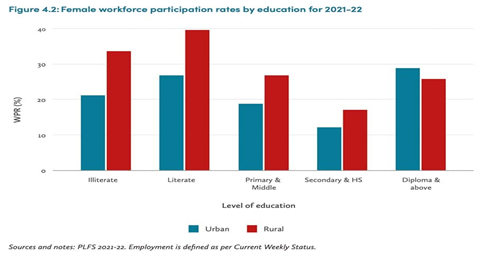

Context
Recently, the ‘State of Working India 2023’ report was released by Azim Premji University’s Centre for Sustainable Employment.
Highlights of the Report:
- About: It uses data sources like the National Statistical Office, including Employment-Unemployment Surveys and the Periodic Labour Force Surveys, and has revealed major trends in India’s labour market.
- Findings: The analysis was drawn from seven charts from the report on intergenerational mobility and women’s workforce participation rates:
- Changing composition of employment type, based on caste: Between 2004 and 2018, more sons of fathers who did casual wage work are now getting better jobs, except for Scheduled Caste workers, where progress is slower.
- Between 1983 and 2021, more Scheduled Caste (SC) workers have regular wage jobs, but the proportion is lower than for general caste workers. SC workers also have higher self-employment rates.
- Intergenerational mobility matrices over time disaggregated by caste, for SC/ST groups:
- Between 2004 and 2018, more sons of fathers who did casual wage work are now getting better jobs, except for Scheduled Caste workers, where progress is slower.
- Between 1983 and 2021, more Scheduled Caste (SC) workers have regular wage jobs, but the proportion is lower than for general caste workers.
- SC workers also have higher self-employment rates.
- Industries showing an overrepresentation of Women, SCs:
- In 2018, there was more economic mobility for sons of general caste casual wage workers compared to SC/STs.
- Sons of casual wage workers shifted towards informal, semi-formal, and regular wage work.
- Casual wage work had the highest intergenerational persistence, while regular wage work showed less persistence.
- Relationship between husband’s earnings and probability of women’s employment:
- In rural areas, as the husband's income increases, the decline in the wife's employment probability slows down.
- In urban areas, there's a U-shaped pattern: the wife's employment probability falls until the husband's income reaches Rs. 40,000, then rises because higher-income husbands often have well-educated wives with access to good jobs.
- Female workforce participation rates by education for 2021-22:
- The presence of an employed mother-in-law significantly increases the likelihood of married women being employed, whereas an unemployed mother-in-law decreases this likelihood.

- The presence of an employed mother-in-law significantly increases the likelihood of married women being employed, whereas an unemployed mother-in-law decreases this likelihood.
- On the rising share of workers in the non-agricultural sector, compared to organised/regular wage employment sectors:
- The share of non-agricultural sector workers increased from the 1980s, reaching 19.8% in 2021 (20.3% in the late 2010s). However, many shifted to casual wage labor or informal work instead of organized or salaried employment.
- Unemployment in India is concentrated among its educated youth:
- Unemployment rates are highest among graduates under 25, decreasing with lower education levels. As people age, employment probability rises.


